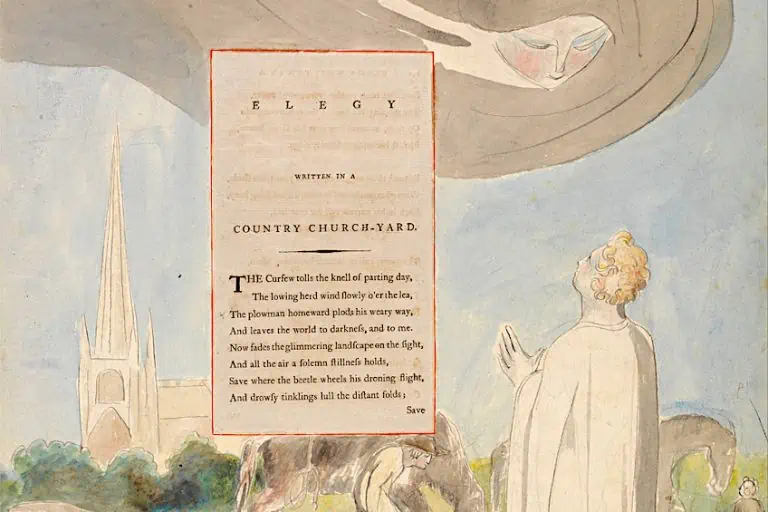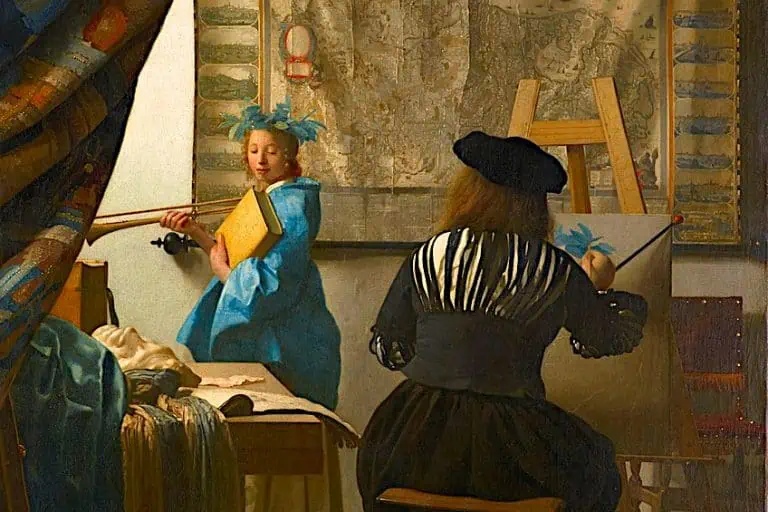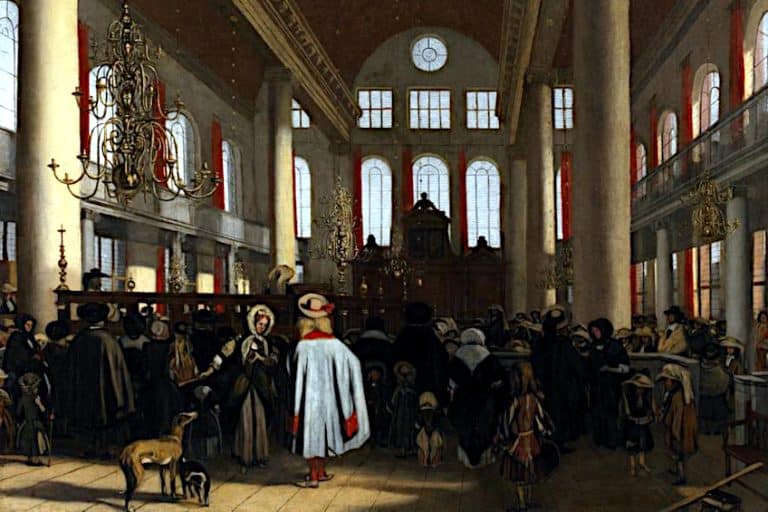Famous American Artists – Exploring American Art Classics
This post may contain affiliate links. We may earn a small commission from purchases made through them, at no additional cost to you.
For ages, visual art has been created in many forms in America, ranging from traditional American art created by early indigenous groups (which included a variety of different media and styles) to more recent contemporary art, which appeared after the arrival of the Europeans and looked toward portraiture and landscapes. The United States has a rich artistic history that has developed and changed throughout the years.
Table of Contents
- 1 12 of the Most Famous American Painters
- 1.1 Grant Wood (1891 – 1942)
- 1.2 Jean-Michel Basquiat (1892 – 1988)
- 1.3 Augusta Savage (1892 – 1962)
- 1.4 Norman Rockwell (1894 – 1978)
- 1.5 Frida Kahlo (1907 – 1954)
- 1.6 Agnes Martin (1912 – 2004)
- 1.7 Jackson Pollock (1912 – 1956)
- 1.8 Luz Donoso (1921 – 2008)
- 1.9 Roy Lichtenstein (1923 – 1997)
- 1.10 Andy Warhol (1928 – 1987)
- 1.11 Clemencia Lucena (1945 – 1983)
- 1.12 Keith Haring (1958 – 1990)
- 2 Frequently Asked Questions
12 of the Most Famous American Painters
There have been hundreds of famous American painters throughout history with all different types of paintings and mediums that all hold special meaning to the artist and their history. Below we will be going into detail about 15 great American painters. If you are interested in art history, you should definitely visit artfilemagazine.com. They offer articles about famous artists, artworks and all art periods and movements.
 Fall Plowing (1931) by Grant Wood;; Grant Wood, Public domain, via Wikimedia Commons
Fall Plowing (1931) by Grant Wood;; Grant Wood, Public domain, via Wikimedia Commons
Grant Wood (1891 – 1942)
| Nationality | American |
| Where the Artist Lived | Cedar Rapids and Anamosa, Iowa |
| When the Artist Lived | 13 February 1891 – 12 February 1942 |
| Associated Art Movements | Regionalism |
| Most Famous Artworks | ● American Gothic (1930) ● Young Corn (1931) ● Spring in Town (1941) |
American fine artist and oil painter of America, Grant DeVolson Wood was a great American painter who was best known for his paintings exhibiting the rural American Midwest. Wood was born on February 13, 1891. His mother was Hattie Weaver and his father was Francis Maryville Wood. He had three siblings, and his early life was spent in Iowa on a small farm. Wood always showcased an interest in art and drawing.
When he was 14, he came third place in an art competition he truly became invested in. He then further studied art in design and became an illustrator. Later in life became an art teacher by resigning to focus on painting. The first exhibition of his works was in Paris at the Gallerie Carmine as he got no recognition for his art in America.
He was soon commissioned to do a large gothic-style stained-glass window, which took him two years to complete. One of his most famous paintings, American Gothic, which was influenced by a gothic window that impressed him, was displayed at the Chicago Art Institute Annual Exhibition. This was where his work finally began to be recognized. Some of his most famous artworks that are considered American art classics include American Gothic (1930), Young Corn (1931), and Spring in Town (1941).
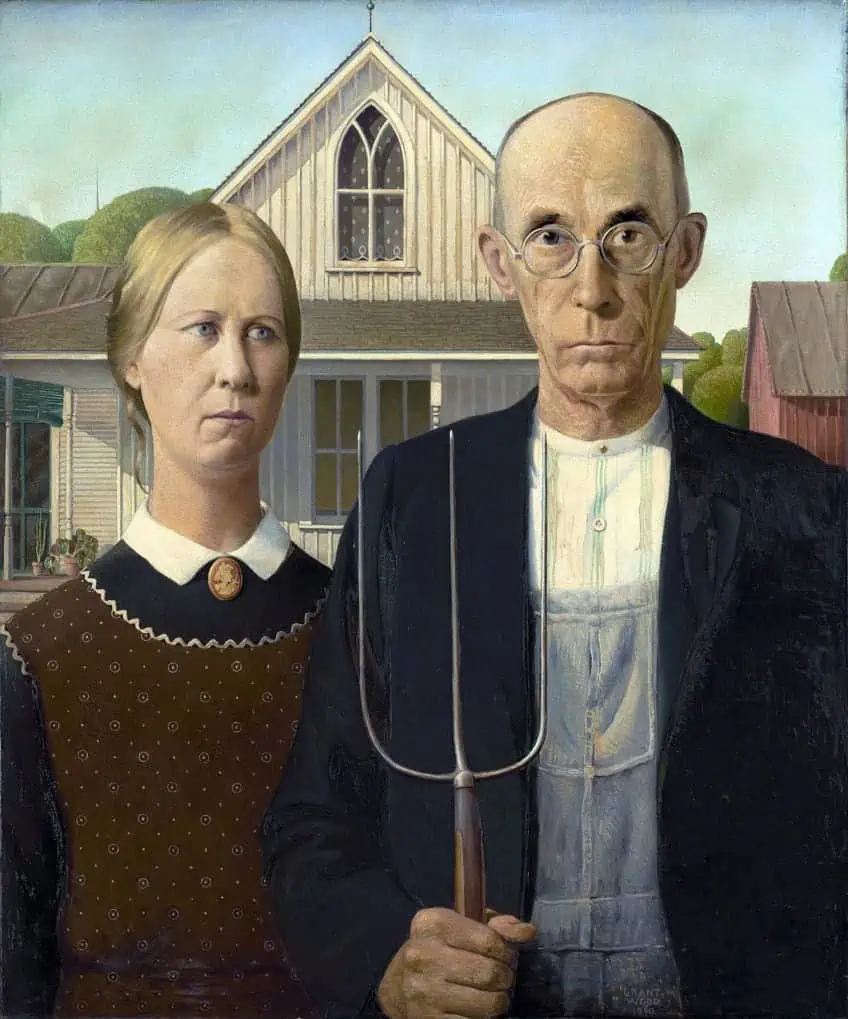 American Gothic (1930) by Grant Wood; Grant Wood, Public domain, via Wikimedia Commons
American Gothic (1930) by Grant Wood; Grant Wood, Public domain, via Wikimedia Commons
The vast landscaping of where he lived would become a large influence on his future paintings and his future success as a painter. He created his art during the Great Depression and his paintings of beautiful and wholesome landscapes and farms would contrast this dark time of history.
Wood tried to capture the effortless beauty and unique air of the Midwest.
His artworks were influenced by European and German artists, but the paintings would always hold a style of his own. During the 1930s, his artworks became well known. His artworks married the styles of Realism and abstract art. Wood’s work shut down technology and the urban lifestyle during the Regionalism movement in art. The scenes depicted humble and simple everyday life with an anti-modernist style.
Jean-Michel Basquiat (1892 – 1988)
| Nationality | American |
| Where the Artist Lived | Brooklyn and Manhattan |
| When the Artist Lived | 22 December 1960 – 12 August 1988 |
| Associated Art Movements | Contemporary art, Neo-Expressionism, Primitivism |
| Most Famous Artworks | ● Warrior (1982) ● Dustheads (1982) ● In this Case (1983) |
Jean-Michel Basquiat, an oil painter of America, was an American artist who was a part of the Neo-expressionism movement in the 1980s, which at the time he rose to fame. He was born in Park Slope, Brooklyn, New York City on December 22, 1960. Gérard Basquiat was his father and Matilde Basquiat was his mother. He was the second of four siblings and Basquiat was raised Catholic. His mother, Matilde had a love for art and made sure the love for it showed up in Basquiat at a young age by taking him to art museums around where they lived and creating an application for him at the Brooklyn Museum of art.
Basquiat was able to read and write by the age of four as he was a quick learner. He would often draw cartoons and his mother would encourage him. Basquiat wrote a children’s book by the time he was seven. His friend, Marc Prozzo, who he met at a private art school known as Saint Ann’s School, illustrated the children’s book.
In his 10th grade, he began to attend at City-As-School, which was an alternative high school in Manhattan that was home to many young artistic individuals. With encouragement from his teachers, he began to illustrate and write for the school newspaper. Basquiat was first noticed through his graffiti, known as SAMO graffiti when The Village Voice published an article about it. In 1980, Basquiat took part in the Times Square Show, which was a multi-artist exhibition. He was noticed by many art critics. His art began to sell and he was invited to display his art at more and more galleries. Soon he became the youngest artist to ever take part in an exhibit in Germany with his work appearing next to incredibly famous artists such as Andy Warhol.
Basquiat’s work focused on things such as wealth versus poverty and outer versus inner experience. He brought together text and images in his works as well as historical information and contemporary technique. Throughout his paintings, he commented on social politics in his art as a way to portray the way he experienced life in the Black community. Since his death, his artworks have increased in value steadily. Some of his most famous artworks include Warrior (1982), Dustheads (1982), and In this Case (1983).
He was truly a great American painter, and his paintings are considered as American art classics.
Augusta Savage (1892 – 1962)
| Nationality | African-American |
| Where the Artist Lived | Green Cove Springs, Florida |
| When the Artist Lived | 29 February 1892 – March 1962 |
| Associated Art Movements | Harlem Renaissance and Realism |
| Most Famous Artworks | ● Harlem Girl (1935) ● The Diving Boy (1939) ● Portrait Head of John Henry (1949)
|
Augusta Savage, an American fine artist, was born in 1892 in Florida in Green Cove Springs. She was a sculptor as well as an influential activist and teacher who fought for equal rights in the art world for African-Americans. She was one of the most famous American artists. Using natural clay found in her hometown, Savage began to create art. She enjoyed sculpting thoroughly often skipping school to create animals and other small objects. She continued to pursue her passions even though her father did not accept her love for art.
In the early 1920s, she moved to New York City after failing to start up as a sculptor when she was still living in Florida.
She had struggles with money, however, she managed to achieve a spot on an extensive waiting list to study art at a school that did not charge fees. Soon after, she applied to study at a summer art program but was rejected due to her race. This is what started her want to fight to equalize and standardize the arts.
Savage proceeded to sculpt African-American leaders as her first sculpting of W.E.B. DuBois for the Harlem Library was well noted. Her sculptures began to gain recognition and she soon achieved a scholarship to study in Paris at the Academie de la Grande Chaumiere. Her work there was exhibited and won many awards. Savage came back to the United States in 1931 and opened her own art studio called Savage Studio of Arts and Crafts. A couple of years later, she was nominated to the National Association of Women Painters and Sculptors. As an African-American artist, she was the first to be elected of such.
 Augusta Savage posing with her sculpture Realization, created as part of the Works Progress Administration’s Federal Art Project; Archives of American Art, Public domain, via Wikimedia Commons
Augusta Savage posing with her sculpture Realization, created as part of the Works Progress Administration’s Federal Art Project; Archives of American Art, Public domain, via Wikimedia Commons
She spent her life creating moving and powerful work through her sculptures and spent much time teaching her artistic skill to those around her. Some of her most famous work includes Harlem Girl (1935), The Diving Boy (1939), and Portrait Head of John Henry (1949).
She truly was a great American painter.
Norman Rockwell (1894 – 1978)
| Nationality | American |
| Where the Artist Lived | New York and Arlington |
| When the Artist Lived | 3 February 1894 – 8 November 1978 |
| Associated Art Movements | Realism, Impressionism, and Surrealism |
| Most Famous Artworks | ● Saying Grace (1951) ● Girl at Mirror (1954) ● Triple Self-Portrait (1960) ● Home for Christmas (1967) |
Famous American Painter, Norman Rockwell was a 20th-century American painter and illustrator who was most famous for his illustrations of everyday life. He was born in New York City on February 3, 1894. His father was Jarvis Waring Rockwell and his mother was Anne Mary Rockwell. Norman Rockwell had one brother, Jarvis Waring Rockwell Jr., who was a year and a half older than him.
Rockwell began attending art school at the young age of 14. He then proceeded to study at the National Academy of Design and then went to study at the Art Students League. At 18, Rockwell’s first major artistic job came about, which entailed him illustrating a book for an author.
His first paying job was as an artist for Boys’ Life magazine. He then started working at Boys’ Life as the art editor. Rockwell then secured a job at The Saturday Evening Post. This is where his career began to start successfully.
He created his art to define what it meant to be “all-American”. His artworks were unique as they were known to evoke an intense emotional response in his viewers. The artworks he created were incredibly relatable to the viewer and would bring up personal memories.
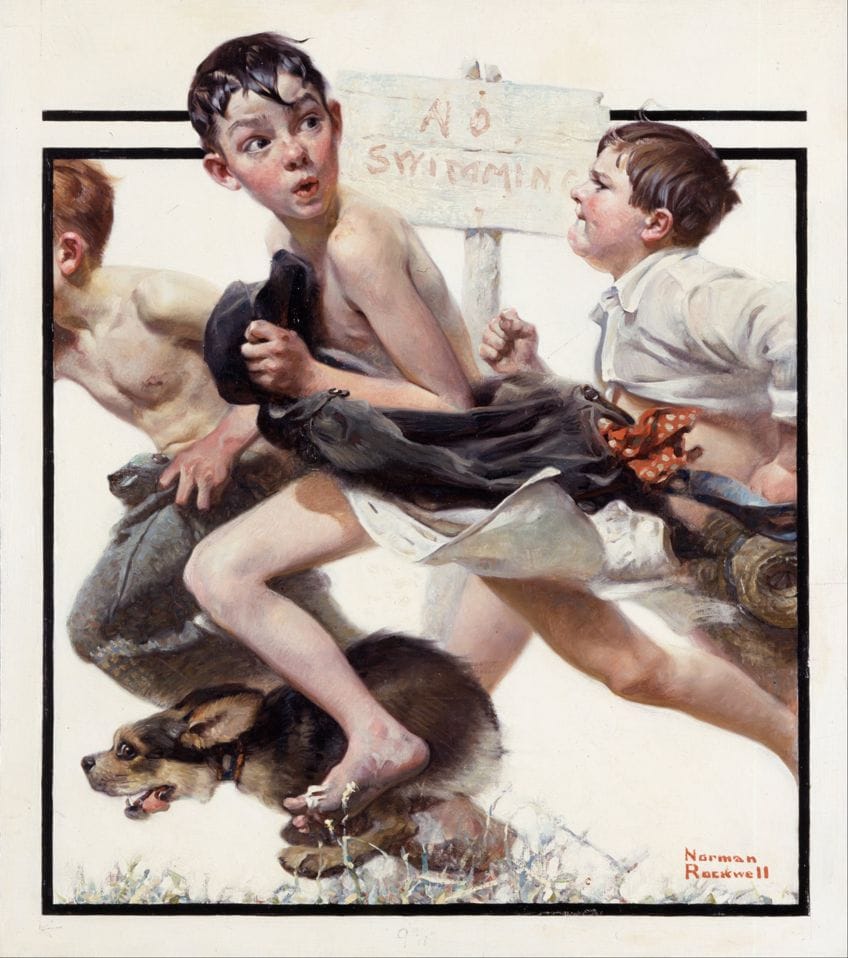 No Swimming (1921) by Norman Rockwell; Norman Rockwell, Public domain, via Wikimedia Commons
No Swimming (1921) by Norman Rockwell; Norman Rockwell, Public domain, via Wikimedia Commons
His works told the story of a collectively united America. He is the most well-known for the cover art of normal everyday life that he created for The Saturday Evening Post magazine, which he did for around five decades. He is also known for the covers he created for the Boy Scouts of America for their Boys’ Life (which were some of his early works) calendars, which he did for 64 years.
Rockwell created an impressive 4,000 original artworks in his lifetime.
Some of Rockwell’s most famous works include Saying Grace (1951), Girl at Mirror (1954), Triple Self-Portrait (1960), and Home for Christmas (1967). Norman Rockwell’s art to this day carries on to influence many other artists and their work. He was most definitely a great American painter.
Frida Kahlo (1907 – 1954)
| Nationality | Mexican |
| Where the Artist Lived | Coyoacán, Mexico City, Mexico |
| When the Artist Lived | 6 July 1907 – 13 July 1954 |
| Associated Art Movements | Surrealism |
| Most Famous Artworks | ● The Two Fridas (1939) ● The Broken Column (1944) ● Without Hope (1945) ● The Wounded Deer (1946) |
Frida Kahlo was a Mexican artist who was the most influential artist of Latin American modernism. She was born in Coyoacán, Mexico City, Mexico on July 6, 1907. Her mother was half Amerindian and half Spanish and her father was of German ancestry. Frida Kahlo had one younger sister and two older sisters. Kahlo suffered from poor health in her childhood with diseases such as polio, which left her bedridden for months. She was one of the great oil painters of America.
With her father’s encouragement, she took part in multiple sports to help her recover from the disease. She was close with her father all through her life. Kahlo attended the National Preparatory School in Mexico City where she met a famous Mexican muralist known as Diego Rivera.
She would watch him paint a mural on the school campus frequently and soon became infatuated with him. Soon Kahlo joined a group of students who shared the same political views. She soon fell in love with the leader of the group.
One afternoon traveling with her lover on a bus, a tragic accident took place, which left her badly injured. During her time bedridden, she began to paint. Her art addressed themes of her illness, melancholy, politics, and indigenous beauty. Her art that of surrealist qualities. She became well known through her paintings, as they were uncompromising and dealt with sensitive themes, and left a profound emotion in the viewer.
Her earlier paintings show influence from Renaissance art. Toward the end of the decade, she drew inspiration more from Mexican folk art. The history of Mexico was brought forth in her art. Her art built a togetherness of cultural ideals and social morals that today are important for her country back then and today. Some of her most famous artworks consist of The Two Frida’s (1939), The Broken Column (1944), Without Hope (1945), and The Wounded Deer (1946).
She is remembered and celebrated today for her passion and bravery throughout life with her art inspiring many.
Agnes Martin (1912 – 2004)
| Nationality | American and Canadian |
| Where the Artist lived | New York, Vancouver, and Taos |
| When the Artist Lived | 22 March 1912 – 16 December 2004 |
| Associated Art Movements | Contemporary art, Modern art, Abstract Expressionism, and Hard-Edge Painting |
| Most Famous Artworks | ● The Islands (1961) ● Tremolo (1962) ● On a Clear Day (1973) |
Agnes Martin, a famous American artist, was a Canadian abstract painter whose work has been described as an inward reflection of the psyche. Her work is often associated with minimalism; however, she considered her work to be that of abstract expressionism. In Abstract Expressionism in the 20th century, she was one of the leading artists. She was born in Macklin, Saskatchewan, Canada, on March 22 in 1912, and was one of four children. She preferred higher education in the United States and decided to move there in 1931.
She became interested in modern art while living in New York City.
She soon began to seriously consider taking up a career as an artist. She finished studying at the University of New Mexico, where she taught art classes. She moved to New York shortly after and lived in a loft with multiple other artists. This space was also a safe space for the queer community. Martin herself was a closeted homosexual. Martin was publicly known to have Schizophrenia and went through multiple procedures in order to help with it. Her struggle, however, was deeply personal.
She is known as an American artist but she never forgot about her Canadian roots, often influencing her art and the scenes in them. Her early works are simplified fields. It is said that she created these scenes to be simplified on purpose to allow free interpretation of the viewer. In 1975 while living in New Mexico she created a group of paintings that were exhibited frequently.
Martin is best known as a painter of grids, where the lines are seemingly perfect, but with closer inspection, a sense of human hand is portrayed. Her artworks had a mysterious quality to them, yet had a sense of calm too. Some of her most famous grid paintings include The Islands (1961), Tremolo (1962), and On a Clear Day (1973).
Her paintings are known to evoke numerous different emotional states, and her art has been exhibited across the world.
Jackson Pollock (1912 – 1956)
| Nationality | American |
| Where the Artist Lived | Cody, Wyoming, and Chico, California |
| When the Artist Lived | 28 January 1912 – 11 August 1956 |
| Associated Art Movements | Abstract Impressionism |
| Most Famous Artworks | Mural on Indian Red Ground (1950) Autumn Rhythm (1950) Convergence (1952) The Deep (1953) |
Paul Jackson Pollock was an American oil painter born on January 8, 1912, in Cody, Wyoming to his father, LeRoy Pollock, and his mother, Stella May McClure. His mother was an artist and his father was a farmer. He was the youngest of five brothers, leading to him not getting as much attention as he desired. Early on in Pollock’s life, his father left the family leading to his older brother, Charles, becoming the father figure.
Charles was an artist, which was a major influence on Pollock’s future ambitions. Later in life, Pollock joined the Manual Arts High School. This is where he came upon his passion for art. He later left the school in pursuit of his creativity.
Pollock became a major figure and influence in the abstract expressionism movement. He was most famous for what is known as the “drip technique”. This entailed splashing and pouring paint onto the surface he was painting on. This allowed him to paint and see his canvas from various angles. This was also known as action painting as he used the movement and force of his entire body to paint, mimicking dancing. The art critics either loved or hated this unique style of painting.
Pollock’s work greatly influenced other contemporary artists and many other art movements. His work was and still is highly respected among other artists pursuing this style due to the deeply personal meanings and symbolism behind them. Some of Pollock’s most famous artworks include Mural on Indian Red Ground (1950), Autumn Rhythm (1950), Convergence (1952), and The Deep (1953).
As an American painter, Pollock was one of the first to be noticed during his life.
Luz Donoso (1921 – 2008)
| Nationality | Chilean |
| Where the Artist Lived | Santiago, Chile |
| When the Artist Lived | 1921 – 18 January 2008 |
| Associated Art Movements | Muralism movement |
| Most Famous Artworks | ● Instituto Chileno Francés (1976) ● Chilenas en Berlin (1983) |
Latin American fine artist Luz Donoso Puelma was a muralist, political activist, graphic artist, and teacher. She was born in 1921 in Santiago Chile. She was a socially minded artist with most of her work remaining unknown. Donoso began her studies in medicine but decided to not complete her degree. In 1963 at the Escuela de Bellas Artes, Universidad de Chile in Santiago, she began to study mural painting. This is also where she became involved in a group of mural painters.
These mural painters supported Salvador Allende from the Socialist Party and his presidential campaign.
Donoso believed in creating art that represented a revolution and that directly addressed the public. Her beliefs were leftist, which led her to be fired from her teaching position of graphic arts at the Universidad de Chile after the first few months of Pinochet’s dictatorship due to opposing beliefs. Soon after being fired, she co-founded Taller de Artes Visuales, which was an artist-run workspace. This led to major forward-thinking political art being created, which was widely known in the 1970s in Chile. The workshop, co-run by Donoso taught and encouraged its students how to question and figure out how to enact political actions in public space.
Following the opening of this workspace, she opened her first major solo exhibition at the French-Chilean Cultural Center. This was in the hope to spread the urgency of the messages portrayed in her art to the public. Donoso was a restless artist, constantly working between her artistic practice and political action. She was given the nickname “Firefly” due to her restlessness. Some of her most famous mural exhibitons include Instituto Chileno Francés (1976), and Chilenas en Berlin (1983).
She is truly deserving of her recognition through the ages and has become one of the most famous Latin-American artists.
Roy Lichtenstein (1923 – 1997)
| Nationality | American |
| Where the Artist Lived | New York City |
| When the Artist Lived | 27 October 1923 – 29 September 1997 |
| Associated Art Movements | Pop art, Modern art, and Abstract Expressionism |
| Most Famous Artworks | ● Masterpiece (1962) ● Crying Girl (1963) ● In the Car (1963) |
Famous American artist Roy Lichtenstein was a leading figure in the 1960s in the Pop Art movement. His art was inspired by comic strips and advertisements. His work was a parodical look into American culture and art culture. Roy Fox Lichtenstein was born to his father, Milton Lichtenstein, and his mother, Beatrice Werner Lichtenstein born on October 27, 1923.
As a boy, he was highly interested in science and comic books. He became interested in art later on in his life in his teens.
In 1937 he began watercolor lessons at Parsons School of Design. In 1940 he began to study beside realist American painter Reginald Marsh at the Art Students league. Soon after he was drafted for World War II. After his time in the war, he completed his studies in fine art with an undergraduate degree and a master’s degree. He then began to work as a commercial-art instructor.
Lichtenstein began to exhibit his art in galleries across the nation. He started off by creating art that paid homage to the 18th century through modernism and then later began experimenting with different subjects and techniques. His art became directly influenced by comic books and advertising.
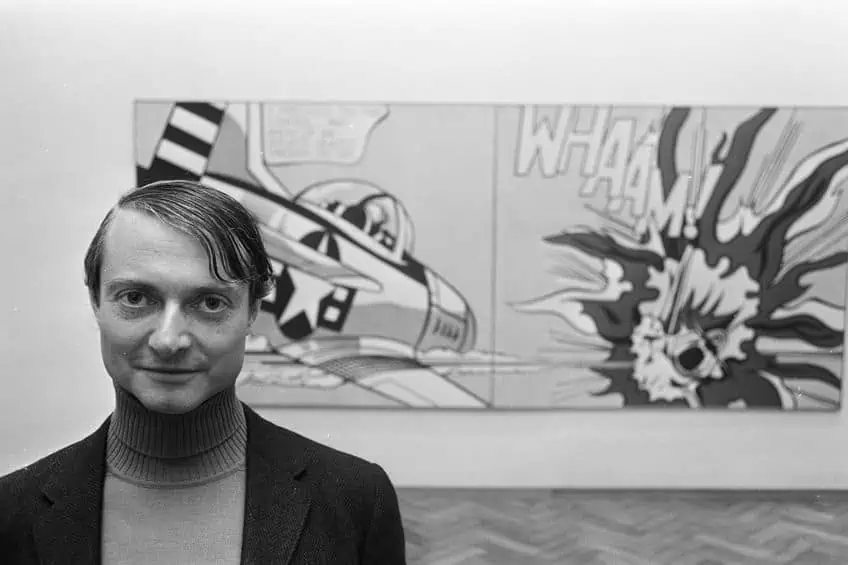 Roy Lichtenstein exhibition at the Stedelijk Museum; Eric Koch, CC0, via Wikimedia Commons
Roy Lichtenstein exhibition at the Stedelijk Museum; Eric Koch, CC0, via Wikimedia Commons
Lichtenstein’s work became widely known as he became known for his flat and sarcastic humor in his paintings and his technique of creating his paintings based on mass-produced images. Soon he became recognized as one of the top artists in the Pop Art movement alongside famous artists such as Andy Warhol. His art became popular with art collectors and dealers. His art created a conversation about the thin connection between fine art and entertainment. Some of his most famous artworks include Masterpiece (1962), Crying Girl (1963), and In the Car (1963).
To this day, his works inspire many artists and their art pieces.
Andy Warhol (1928 – 1987)
| Nationality | American |
| Where the Artist Lived | Pittsburgh, Pennsylvania |
| When the Artist Lived | 6 August 1928 – 22 February 1987 |
| Associated Art Movements | Pop art and Modern art |
| Most Famous Artworks | ● Campbell’s Soup Cans (1962) ● Marilyn Diptych (1962) ● The Experimental Films Empire (1962) ● Chelsea Girls (1966) |
Andy Warhol was a victorious illustrator who later became the chief artist of the Pop art movement during the 1960s. Warhol was born in Oakland Pittsburgh on August 6, 1928. His father was Andrej Warhol and his mother was Julia Warhol. His parents were both Slovakian immigrants.
Warhol contracted a rare disease that attacks the nervous system known as Chorea at the age of eight, which left him bedridden for numerous months. While Warhol was sick, his mother gave him his initial drawing tutorial. Soon, drawing became Warhol’s favorite thing to do. When he turned nine, his mother bought him a camera and he soon became interested in photography.
Warhol took up free art classes and later in life and joined the Carnegie Institute for Technology. In 1949, he graduated from college with a Bachelor of Fine Arts. He then went to New York City to live there and to follow his dream of being a commercial artist. He soon got a job with Glamour magazine and in the 1950s he soon became one of the most triumphant commercial artists.
Later in the 1950s, he started to spend more time painting and in 1961 he brought forth the idea of “pop art”. Pop art was about paintings that were to be mass-produced commercial goods. His first pop-art debut showed up on Campbell’s Soup Cans (1962).
This debut of pop art on soup cans was what brought Warhol and pop art into the spotlight for the first time.
Warhol’s work is still highly recognized today and has been the main topic of many exhibitions as well as books and films. Warhol also created numerous films between the years 1963 and 1968. Some of Warhol’s most famous artworks consist of Campbell’s Soup Cans (1962) and Marilyn Diptych (1962), as well as the experimental films Empire (1962) and Chelsea Girls (1966).
Clemencia Lucena (1945 – 1983)
| Nationality | Columbian |
| Where the Artist lived | Bogotá, Columbia |
| When the Artist Lived | 5 December 1945 – 24 July 1983 |
| Associated Art Movements | Post-War and Contemporary art |
| Most Famous Artworks | ● Preclara Dama (1970) ● Clases de Glamour y pintur (1971) |
Clemencia Lucena was a Colombian painter, critic, and painter. She was born in Bogotá, Columbia in 1945. At the Universidad de Los Andes in Bogotá, she studied sculpture. Lucena is known for her work displaying two different categories. The first category displays her feminist views and parodies of women in beauty pageants and gendered habits and her far-left-leaning representations in paintings showcasing class struggle.
Her early work mocks the idealized representation of women in beauty pageants, weddings, and debutante announcements.
This was a feminist stance on these happenings. For these artworks, she referenced photography by using clippings of newspaper and the images on it. She would remove the context from these newspaper clippings, leaving behind just the photograph. This first phase of work lasted within the years of 1967 to 1971. One of her most famous artworks during this era of art is
The second phase of her work was radically different than the first phase and was influenced by socialist and realist views when she joined the Movimiento Obrero Independiente Revolucionario (MOIR). This was a Maoist group that was founded in 1969. Her artworks during this time represented the struggles of union workers and peasants.
Many of her works during this time could be seen as political propaganda which encouraged social action in the working class.
Her work is seen as a fight to give a voice to women in a male-dominated world. In 1975 she then published a series of essays in which she supported the need for new art forms that are opposed to colonialism and imperialism. Two of her most famous artworks include Preclara Dama (1970), and Clases de Glamour y pintur (1971).
Keith Haring (1958 – 1990)
| Nationality | American |
| Where the Artist Lived | Reading, Pennsylvania |
| When the Artist Lived | 4 May 1958 – 16 February 1990 |
| Associated Art Movements | Pop art and Contemporary art |
| Most Famous Artworks | ● Crack is Wack (1986) ● Safe Sex (1988) ● Radiant Baby (1990) |
Keith Haring was an American fine artist whose work was that of the Pop-Art movement. It came about from the New York City graffiti subculture during the 1980s. His artwork has become a well-known and recognized visual language. Raised in Kutztown in Reading, Pennsylvania, Haring was born on May 4, 1958. He grew a love for art and drawing at a young age. He learned basic cartoon skills that his father taught him. He was inspired by well-known cartoonists such as Dr. Suess and Walt Disney.
He had the first solo exhibition of his work in 1978 at the Pittsburgh Arts and Crafts center after studying at the Ivy School of Professional Art in Pittsburgh and further dropped out as he had little interest in becoming a commercial graphic artist.
Later that year he joined the School of Visual Arts alongside artists such as Jean-Michel Basquiat who he became close friends. He thrived in the alternative art community there. He then began to organize and take part in exhibitions and performances in Club 57 and other alternative locations.
Haring was further influenced by other public art figures which led him to devote his career to public art. He began to create illustrations in subways and soon his art became familiar and recognizable to New York commuters. He soon gained international recognition and displayed his work in numerous exhibitions. He took part in numerous public projects for large brands such as Swatch and Absolut Vodka. In 1986, he decided to open a retail store, as he wanted his work to be accessible to the masses.
Haring proceeded to create murals for things like the 100th anniversary of the Statue of Liberty and the Berlin Wall three years before its demolition. He also held workshops for children and museums across the world. Haring was a highly sought-after artist during his short but intense career. Keith Haring’s work is seen today in great museums across the world. Some of his most famous artworks include Crack is Wack (1986), Safe Sex (1988), and Radiant Baby (1990).
American art has gone through many different phases throughout time with the artists creating art with many different meanings and messages as well as styles ranging from Pop Art to Abstract Impressionism. Each of the 12 famous American Painters and art described is incredibly unique and influential with their own personal stories leading up to their artistic career. These are only a few famous American artists out of hundreds of influential artists throughout America. We hope that you decide to delve deeper into the world of American art and artists.
Frequently Asked Questions
What Defines American Art?
Visual art in the United States is defined as art created by U.S artists. Art wasn’t always contemporary in America as before colonization many flourishing traditions and art were being created by Native Americans.
What Are the Most Popular Types of Art in America?
The most popular types of art in America include sculpture, painting, prints, and photography. It is recorded by The Contemporary Art Market Report recorded that the most used mediums in America were sculpture at 16% and painting at 65%.
Why Is American Art Important?
American art is important as it tells a long-told story of mankind and its evolution. One of the best ways to get a feel for the history and stories of America is through pictures created by artists. Art telling a story of the history of America is much more enticing than written text.
In 2005, Charlene completed her wellness degrees in therapeutic aromatherapy and reflexology at the International School of Reflexology and Meridian Therapy. She worked for a company offering corporate wellness programs for several years before opening her own therapy practice. In 2015, she was asked by a digital marketer friend to join her company as a content creator, and it was here that she discovered her enthusiasm for writing. Since entering the world of content creation, she has gained a lot of experience over the years writing about various topics such as beauty, health, wellness, travel, crafting, and much more. Due to various circumstances, she had to give up her therapy practice and now works as a freelance writer. Since she is a very creative person and as a balance to writing likes to be active in various areas of art and crafts, the activity at acrylgiessen.com is perfect for her to contribute their knowledge and experience in various creative topics.
Learn more about Charlene Lewis and about us.

